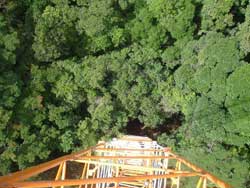Land plants process 15 percent of total atmospheric carbon dioxide each year

The canopy of the Ankasa tropical forest, in Ghana, Africa, picture taken from a flux tower. <br>Credit: Carboafrica, www.carboafrica.net <br>
The researchers evaluated the result against spatially explicit process models including the leading model LPJmL from PIK. Tropical ecosystems such as rain forests and savannas account for almost two thirds of the CO2 uptake, they report in an article published by the journal “Science” on the “Science Express” web site today.
“Our results confirm the major role of rainfall for the global carbon cycle: It controls plant uptake of CO2 for over forty percent of all vegetated land,” says Alberte Bondeau of the Potsdam Institute for Climate Impact Research (PIK), who contributed computer simulations of global vegetation to the study. Patterns of precipitation are expected to undergo substantial changes with global warming. “This could profoundly affect the productivity of land ecosystems,” Bondeau notes.
The researchers used information from a global network of observation stations to quantify the exchange of CO2 between different ecosystems and the atmosphere. More than 250 observation towers provide continuous measurements. The team used these data to train diagnostic computer models which were then used to compute the value of total worldwide uptake of CO2 by vegetation, the so-called gross primary production of the terrestrial biosphere.
The value of ca. 450 billion tonnes per year describes the total volume of fixation of CO2 in the process of photosynthesis on land and is a function of environmental conditions, particularly of climate variables and vegetation properties. The carbon removed from the atmosphere in this manner later returns to it on various time scales: a large fraction returns quickly due to plant respiration, another large fraction more slowly when leaves decay or woody material decomposes in the soil, or through wildfires. The delay in the return of some of the CO2 fixed by plants to the atmosphere is an important factor controlling the rate of climate change due to human emissions.
Despite its central importance to the global carbon cycle, the study now published is the first to constrain global CO2 intake by vegetation with reasonable confidence. It confirms the prominent role of tropical vegetation in the land carbon cycle and points to a strong relationship between CO2 uptake and precipitation for extended regions of the world.
The research team also compared the observation-based estimate to the results of process-oriented computer models of global ecosystems. Such models are used to assess the future development of the land carbon balance under climate change. Both versions of the model developed at PIK, one for global potential natural vegetation (LPJ) and one including the effects of worldwide agricultural land use (LPJmL) were studied.
The findings show that currently available process models reproduce latitudinal differences in carbon uptake by land vegetation but differ in the simulated magnitude and variation of the process and overestimate the precipitation effect on the gross CO2 uptake. This indicates that additional mechanisms, e.g. adaptation, may serve to attenuate the vegetation response to climate. PIK's LPJmL model, which takes into account the effects of agriculture and especially irrigated croplands, correctly reproduced a reduced sensitivity of carbon uptake to precipitation, though it remains an important climatic factor. The exact causes of the mechanism deserve further study.
“These results are hugely important: They take our understanding of the role of the land surface in climate regulation through CO2 exchange and of global biomass production to the next level. In terms of our ability to model the future, we are on much more solid grounds now,” says Wolfgang Lucht, Co-Chair of PIK’s Department of Climate Impacts and Vulnerability. “The numbers show that amazingly, every seven years all of the carbon dioxide contained in the atmosphere flows once through the world’s leaves. It is one of the most important processes on the planet and we now have a reliable estimate of the magnitude of this flux.”
Article: Beer, C., M. Reichstein, E. Tomelleri, P. Ciais, M. Jung, N. Carvalhais, C. Rödenbeck, M. Altaf Arain, D. Baldocchi, G. B. Bonan, A. Bondeau, A. Cescatti, G. Lasslop, A. Lindroth, M. Lomas, S. Luyssaert, H. Margolis, K. W. Oleson, O. Roupsard, E. Veenendaal, N. Viovy, C. Williams, I. Woodward, and D. Papale, 2010: Terrestrial Gross Carbon Dioxide Uptake: Global Distribution and Co-variation with Climate. Published within the “Science Express” web site: http://www.sciencemag.org/sciencexpress/recent.dtl
Media Contact
All latest news from the category: Ecology, The Environment and Conservation
This complex theme deals primarily with interactions between organisms and the environmental factors that impact them, but to a greater extent between individual inanimate environmental factors.
innovations-report offers informative reports and articles on topics such as climate protection, landscape conservation, ecological systems, wildlife and nature parks and ecosystem efficiency and balance.
Newest articles

Silicon Carbide Innovation Alliance to drive industrial-scale semiconductor work
Known for its ability to withstand extreme environments and high voltages, silicon carbide (SiC) is a semiconducting material made up of silicon and carbon atoms arranged into crystals that is…

New SPECT/CT technique shows impressive biomarker identification
…offers increased access for prostate cancer patients. A novel SPECT/CT acquisition method can accurately detect radiopharmaceutical biodistribution in a convenient manner for prostate cancer patients, opening the door for more…

How 3D printers can give robots a soft touch
Soft skin coverings and touch sensors have emerged as a promising feature for robots that are both safer and more intuitive for human interaction, but they are expensive and difficult…





















